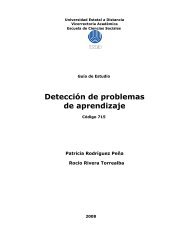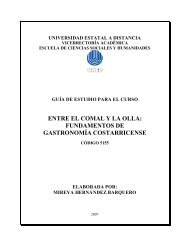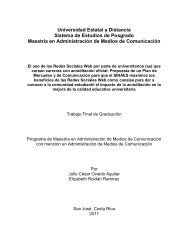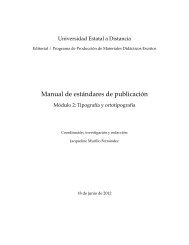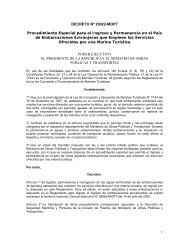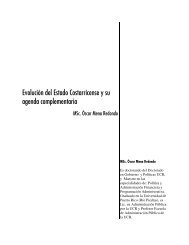GE3011 Cálculo Superior - Repositorio de la Universidad Estatal a ...
GE3011 Cálculo Superior - Repositorio de la Universidad Estatal a ...
GE3011 Cálculo Superior - Repositorio de la Universidad Estatal a ...
You also want an ePaper? Increase the reach of your titles
YUMPU automatically turns print PDFs into web optimized ePapers that Google loves.
98 GUÍA DE ESTUDIO: CÁLCULO SUPERIOR<br />
Por otra parte, el punto (2, 1, 0) se obtiene cuando t = 1 y el punto (4, 4, ln 2) se obtiene<br />
cuando t = 2. Luego, <strong>la</strong> longitud <strong>de</strong> arco es<br />
L =<br />
2<br />
1<br />
<br />
2t + 1<br />
<br />
dt = t<br />
t<br />
2 + ln t 2 = 3 + ln 2.<br />
1<br />
4. (6 puntos) Se <strong>de</strong>be <strong>de</strong>terminar cuándo rot V = 0. Se tiene<br />
<br />
<br />
i j k<br />
<br />
∂ ∂ ∂<br />
rot V = ∇ × V = <br />
∂x ∂y ∂z<br />
my<br />
<br />
x2 + y2 nx<br />
x2 + y2 <br />
<br />
<br />
<br />
<br />
<br />
<br />
0<br />
<br />
<br />
<br />
∂ nx<br />
= 0i + 0j+<br />
∂x x2 + y2 <br />
− ∂<br />
<br />
my<br />
∂y x2 + y2 <br />
k<br />
2 2 2<br />
n (x + y ) − 2nx<br />
=<br />
(x2 + y2 ) 2 − m (x2 + y2 ) − 2my2 (x2 + y2 ) 2<br />
<br />
k<br />
2 2 n (y − x )<br />
=<br />
(x2 + y2 ) 2 − m (x2 − y2 )<br />
(x2 + y2 ) 2<br />
<br />
k<br />
Igua<strong>la</strong>ndo a 0 se tiene n (y 2 − x 2 ) − m (x 2 − y 2 ) = 0 ⇒ (m + n) (y 2 − x 2 ) = 0 para todo<br />
(x, y) = (0, 0), por lo que se <strong>de</strong>be tener m + n = 0.<br />
5. (4 puntos) Se <strong>de</strong>be probar que c ′ (t) = F (c(t)). Se tiene c ′ (t) = (cos t, − sen t, e t ); mientras<br />
tanto F (c(t)) = F (sen t, cos t, e t ) = (cos t, − sen t, e t ). Por lo tanto son iguales.<br />
6. (5 puntos) Consi<strong>de</strong>rando <strong>la</strong> integral interior vemos que x<br />
varía <strong>de</strong> x = 1<br />
2 y a x = √ y. Así, <strong>la</strong> región está comprendida<br />
entre <strong>la</strong> recta y = 2x y <strong>la</strong> parábo<strong>la</strong> y = x 2 . La gráfica <strong>de</strong> <strong>la</strong><br />
.<br />
.<br />
.<br />
.<br />
.<br />
.<br />
.<br />
.<br />
.. . .. . ....<br />
.<br />
.<br />
.<br />
.<br />
.<br />
.<br />
.<br />
.<br />
.. . .. . ....<br />
.<br />
.<br />
.<br />
..................<br />
..................................................................................................................................................................................................................<br />
región se da en <strong>la</strong> figura adjunta.<br />
Para cambiar el or<strong>de</strong>n <strong>de</strong> integración vemos que cuando<br />
y = 4, entonces x = √ 4 = 2 y cuando y = 0, entonces<br />
x = 0. Es <strong>de</strong>cir 0 ≤ x ≤ 2, mientras que, como <strong>la</strong> parábo<strong>la</strong><br />
queda por <strong>de</strong>bajo <strong>de</strong> <strong>la</strong> recta, x2 ≤ y ≤ 2x, por lo tanto<br />
. ... . .. . .. . ...<br />
.<br />
.<br />
.<br />
.<br />
.<br />
.<br />
.<br />
.<br />
.<br />
.<br />
.<br />
.<br />
.<br />
. ... . .. . .. . ...<br />
−2 −1<br />
.<br />
.<br />
.<br />
.<br />
.<br />
2<br />
.<br />
.<br />
.<br />
.<br />
.<br />
. 1<br />
.<br />
.<br />
1 2<br />
x.<br />
.<br />
3<br />
Figura 18: Problema 6.<br />
4 √<br />
y<br />
0<br />
1<br />
2 y<br />
f(x, y)dxdy =<br />
2 2x<br />
0<br />
x 2<br />
UNED Acortando distancias<br />
f(x, y)dydx.<br />
4<br />
3<br />
y



